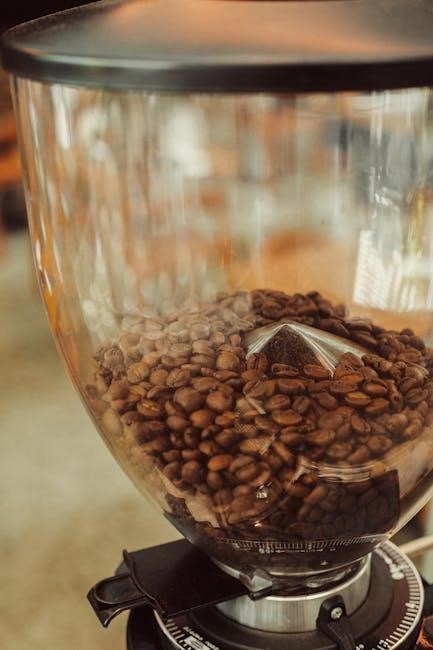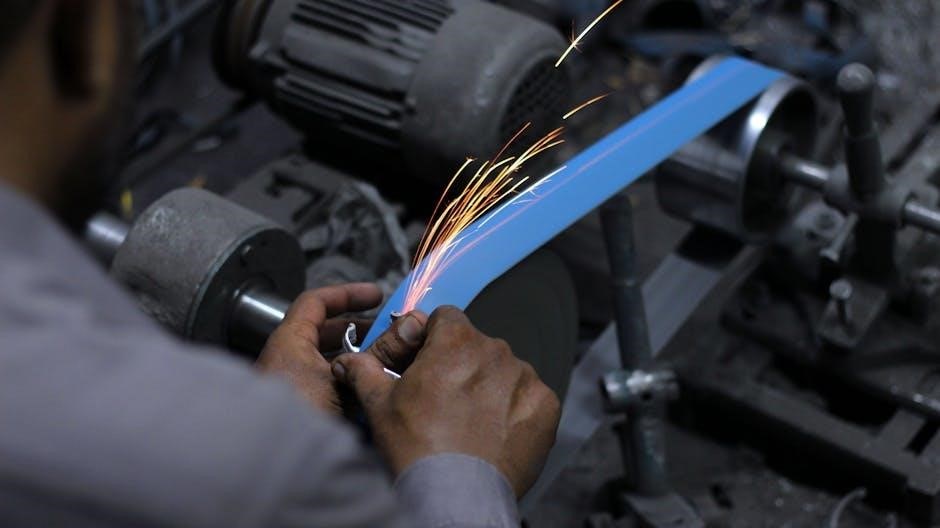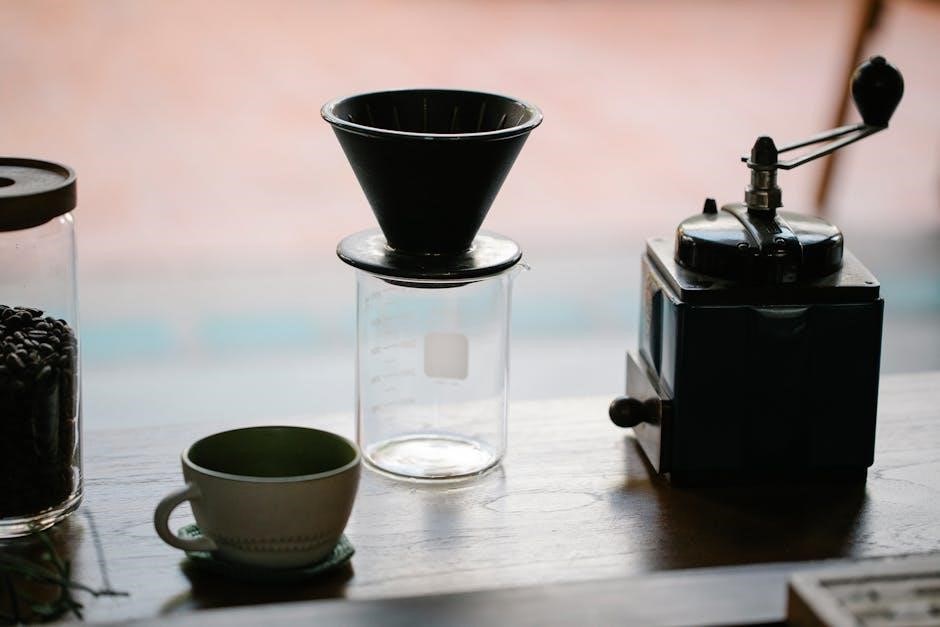Coffee grinders are an essential tool for coffee brewing, offering a choice between electric and manual options to suit different needs, ensuring quality and flavor in every cup.
The Importance of Coffee Grinders in Brewing
Coffee grinders play a pivotal role in the brewing process, as they directly impact the flavor, aroma, and overall quality of the coffee. Freshly ground beans ensure optimal extraction, preserving the coffee’s natural oils and essences. Pre-ground coffee often loses these qualities due to oxidation and exposure to air, heat, and moisture. Whether using electric or manual grinders, the ability to control grind size and consistency is crucial for specific brewing methods, such as espresso, French press, or pour-over. A good grinder allows for precision, enabling users to tailor their coffee experience to their preferences. This makes grinders an indispensable tool for coffee enthusiasts seeking to elevate their daily brew.
Overview of Electric and Manual Coffee Grinders
Coffee grinders are available in two primary types: electric and manual. Electric grinders are powered by motors, offering convenience and speed, while manual grinders rely on hand-crank operation, providing a more traditional experience. Electric grinders often feature blade or burr grinding mechanisms, with burr grinders being preferred for consistent results. Manual grinders typically use ceramic or steel burrs, ensuring precise control over grind size. Both types cater to different preferences and needs, with electric grinders suited for daily use and manual ones appealing to enthusiasts who value the process. Design and build quality vary between models, but both options aim to deliver freshly ground coffee, enhancing the overall brewing experience. Understanding these basics helps users choose the right grinder for their lifestyle and coffee habits.

Key Differences Between Electric and Manual Coffee Grinders
Electric grinders offer speed and convenience, while manual grinders provide precision and control. Electric models are faster but may generate heat, affecting flavor, whereas manual grinders are quieter and portable but require effort and time to operate, making them less suitable for large quantities. Both cater to different preferences and lifestyles, with electric grinders ideal for daily use and manual ones appealing to enthusiasts who value the grinding process and consistent results. The choice depends on priorities like speed, effort, and flavor quality.
Design and Build: Electric vs. Manual
Electric coffee grinders are typically built with durable materials like stainless steel and plastic, featuring compact, modern designs that fit seamlessly into kitchen countertops. They often include additional features such as touchscreens, preset settings, or removable chambers for easy cleaning. Manual grinders, on the other hand, are crafted with a focus on simplicity and portability. Many manual grinders are made from high-quality materials like wood or chrome, offering a sleek, vintage aesthetic. Their design emphasizes ease of use, with a focus on manual effort rather than automation. While electric grinders prioritize convenience and efficiency, manual grinders highlight craftsmanship and tactile experience, appealing to coffee enthusiasts who value tradition and precision in their brewing process.
Operation: How Each Grinder Works
Electric coffee grinders operate with the press of a button, using a motor to rotate stainless steel or ceramic burrs that grind the coffee beans. They are fast and efficient, often featuring adjustable settings for grind size and quantity. Manual grinders, by contrast, rely on manual effort, requiring users to turn a handle that powers the grinding mechanism. This process is slower and more labor-intensive but offers precise control over the grind. Electric grinders are ideal for those seeking convenience and speed, while manual grinders appeal to enthusiasts who value the tactile experience and consistent results achieved through manual operation.
Cost Comparison: Electric vs. Manual
Electric coffee grinders generally have a higher upfront cost compared to manual grinders, with prices ranging from $50 to $300 or more, depending on features and quality. Manual grinders are more affordable, typically priced between $20 and $100, making them a budget-friendly option for casual users. However, electric grinders often come with additional features like timers, multiple grind settings, and larger capacities, which justify their higher price. Manual grinders, while cost-effective, require more effort and time, which may not appeal to everyone. Over time, manual grinders can be more economical since they don’t consume electricity, but electric grinders offer convenience and speed for frequent use. Ultimately, the choice depends on balancing initial cost, long-term savings, and personal preference for convenience versus manual control.

Performance and Quality of Grind
Electric grinders offer speed and consistency, ideal for fine espresso grinds, while manual grinders provide precise control, perfect for coarse brews, with less heat generation.
Speed and Heat Generation in Electric Grinders
Electric coffee grinders are known for their speed, quickly processing coffee beans into a fine grind. This convenience comes with a trade-off, as high-speed motors can generate heat, potentially altering the flavor and aroma of the beans. Excessive heat can lead to static buildup, causing grounds to cling to the grinder. However, many modern electric grinders address this issue with advanced cooling systems or gear designs that reduce friction. While they excel in efficiency, manual grinders often preserve the beans’ integrity better by avoiding heat transfer. For those prioritizing speed and convenience, electric grinders remain a practical choice, but coffee purists may prefer manual options for superior flavor retention.
Manual Grinders: Precision and Control
Manual coffee grinders offer unparalleled precision and control over the grinding process. Because they operate without electricity, they allow users to adjust the grind size with extreme accuracy, ensuring consistency for any brewing method. The manual effort required to turn the handle provides a tactile connection to the coffee, enabling a deeper understanding of the grind. Additionally, manual grinders generate no heat, which helps preserve the delicate flavors and aromas of the coffee beans. This makes them ideal for coffee enthusiasts who value quality and are willing to invest time and effort into their brewing routine. The lack of automation is balanced by the ability to tailor every grind to perfection, making manual grinders a favorite among aficionados seeking ultimate control.
Grind Consistency: Which Grinder Performs Better?
Grind consistency is a critical factor in achieving optimal coffee flavor, and both electric and manual grinders have their strengths. Electric grinders often feature advanced burr sets and automatic settings, which can deliver consistent results with minimal effort. However, lower-end electric models may struggle with uniformity, especially at finer grind settings. Manual grinders, on the other hand, rely on precise engineering and user technique to produce consistent grinds. High-quality manual grinders, such as those with ceramic or steel burrs, often excel in this regard, offering exceptional control over particle size. While electric grinders are faster, manual grinders tend to edge out in consistency for specialty coffee brewing methods like espresso or pour-over. Ultimately, the better grinder for consistency depends on the user’s skill level and willingness to invest time in the process.

Ease of Use and Maintenance
Electric grinders offer convenience and speed, while manual grinders require effort but are easier to clean and maintain with fewer parts. Both need regular upkeep for optimal performance.
User-Friendly Features of Electric Grinders
Electric coffee grinders are designed with convenience in mind, offering one-touch operation and preset settings that simplify the grinding process. Many models feature automatic shut-off, ensuring precise portion control and minimizing waste. Their compact designs often include easy-to-use interfaces, such as buttons or dials, allowing users to adjust grind size effortlessly. Some high-end electric grinders come with built-in scales for accurate measurements, while others offer programmable settings for consistent results every time. Additionally, electric grinders are generally faster, saving time for busy individuals. Cleaning is also streamlined, with removable parts that are often dishwasher-safe. These features make electric grinders a practical choice for those seeking efficiency and ease of use in their daily coffee routine.
The Manual Grinding Process: Effort and Time
Manual coffee grinders require a hands-on approach, involving physical effort to turn the handle and grind the beans. This process can be time-consuming, especially for larger quantities, as it demands consistent manual labor. While some find the ritual meditative, others may find it tiring or impractical for busy mornings. The grind size depends on the user’s ability to maintain a steady pace and pressure, which can take practice to master. However, manual grinders offer a level of control and connection to the coffee-making process that some enthusiasts appreciate. For those who value precision and are willing to invest the time and effort, manual grinding can be a rewarding experience, even if it lags behind electric grinders in terms of speed and convenience.

Cleaning and Maintenance: Electric vs. Manual
Cleaning and maintaining coffee grinders differs significantly between electric and manual models. Electric grinders often have more complex designs, with multiple parts that may require disassembly for thorough cleaning. Regular wiping of the grinding chamber and blades is essential to prevent oil buildup and stale coffee residue. Some electric grinders come with removable and washable components, but others may need special care to avoid damage. Manual grinders, with their simpler mechanisms, are generally easier to clean and maintain. A quick brush or wipe with a cloth usually suffices. However, manual grinders lack the advanced features of electric models, making them less prone to long-term wear but still requiring consistent upkeep to ensure optimal performance and flavor.
Choosing between electric and manual coffee grinders depends on your lifestyle, brewing habits, and personal preferences. Both options offer unique benefits, ensuring a perfect cup tailored to your needs.
Pros and Cons of Each Grinder Type
Electric coffee grinders are known for their speed and convenience, making them ideal for daily use. They often feature preset settings and large capacities, perfect for households. However, they can generate heat, potentially affecting coffee beans’ flavor, and are generally more expensive and noisy. On the other hand, manual grinders offer precise control over grind size and are quieter and more affordable. They also avoid heat generation, preserving coffee’s aroma. However, manual grinding requires physical effort and time, especially for large quantities. Ultimately, electric grinders suit busy individuals, while manual grinders appeal to those valuing precision and traditional brewing methods.
Choosing the Right Grinder for Your Needs
Selecting between electric and manual coffee grinders depends on your lifestyle, brewing habits, and preferences. If you value convenience and speed, electric grinders are ideal, especially for those with busy schedules. They are perfect for making multiple cups quickly and offer preset settings for ease of use. However, if you prioritize precision and control over your grind size, manual grinders are a better fit. They are quieter, more affordable, and allow for a more hands-on, traditional coffee-making experience. Consider your budget, the amount of coffee you brew daily, and your tolerance for manual effort. Additionally, think about noise levels and storage space. Ultimately, the choice balances convenience, quality, and personal effort, ensuring you enjoy the perfect cup tailored to your preferences.
